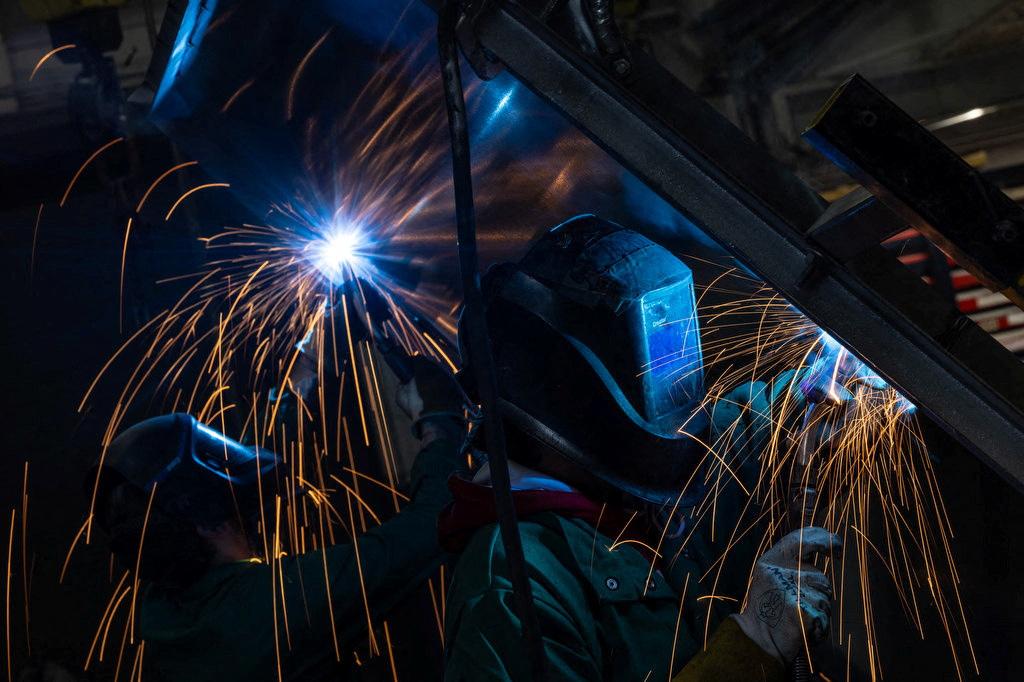
2024-09-03 10:25
OSLO, Sept 3 (Reuters) - Norway's Aker BP (AKRBP.OL) , opens new tab has started production at its Tyrving offshore oilfield, as the Norwegian government seeks to overturn a court ruling that its approval of the project was invalid because it failed to assess the climate impact. In January, Oslo District Court ruled in a case brought by environmental groups that Norway's energy ministry had failed to fully assess the climate impact from the production of oil and gas when approving three offshore projects, including Tyrving, and that permits were thus invalid. The government is appealing that ruling and a hearing on a part of the case is due to start on Wednesday. A final ruling on all aspects could be months or years away. Aker BP Chief Executive Karl Johnny Hersvik is expected to testify this week at the Borgarting Court of Appeal at the behest of the government. While Aker BP is not a party to the lawsuit, the company's output could suffer if permits are withdrawn. The original lawsuit brought by Greenpeace and Young Friends of the Earth also challenged approvals of Aker BP's Yggdrasil and Equinor's Breidablikk projects. The environmentalists argued that the energy ministry failed to assess the global impact from emissions generated when oil and gas is used. "It's shameless of Aker BP to start up this oilfield and the state to allow it when we are entering the appeals hearing," Frode Pleym, head of Greenpeace Norway, told Reuters. Aker BP said the field's start-up had no connection with the court case, and a permit to start production was issued by Norwegian Offshore Directorate, an industry regulator, on Aug. 13. The Tyrving field in the offshore Alvveim cluster is estimated to hold 25 million barrels of oil, and was previously expected to start in the fourth quarter of this year. Breidablikk started production in October 2023, while Yggdrasil is expected to start in 2027. Sign up here. https://www.reuters.com/business/energy/aker-bp-starts-production-tyrving-oilfield-amid-governments-legal-battle-over-2024-09-03/

2024-09-03 10:22
US central bank expected to cut rates later this month Incoming data will shape size of anticipated rate cut Fed policymakers agree inflation is cooling Sept 3 (Reuters) - As recently as two and a half months ago, most U.S. central bankers didn't see an interest rate cut in the cards at their Sept. 17-18 meeting. By the end of last month, when Federal Reserve Chair Jerome Powell said it was time to start lowering borrowing costs, nearly all of his colleagues thought so too. In large part, that was because a wide range of data moved in one direction. That pushed Fed policymakers to reassess the risks to their outlook, including whether their chief concern should be persistent inflation, labor market weakness, a deterioration in business or household financial conditions, a potential policy mistake, or some combination of those factors. "It's not one thing that causes everyone to move. It's different people focus on different data, different indicators, different risks, and then they all end up in the same place," said Kristin Forbes, an economics professor at MIT's Sloan School of Management and a former member of the Bank of England's policy-setting committee. Speaking on the sidelines of the Kansas City Fed's annual economic symposium in Jackson Hole, Wyoming, last month, where Powell declared the time had come for U.S. rate cuts, Forbes said: "And that's where a good (Fed) Chair can bring people together to get the outcome they want, but often by drawing on different motivations to get different people there." At least a couple of Fed policymakers appear to still be on the fence, their support for policy easing contingent on further signs of a slowdown in inflation or weakness in the labor market. But for the vast majority of Fed policymakers, a first reduction in rates after a grueling inflation fight is all but a certainty this month. Incoming information, buttressed by their view of data already seen, will shape how big a move they favor at the meeting in two weeks: A typical quarter-percentage-point cut or an up-sized half-percentage-point move. Fed policymakers have not unfurled a "mission accomplished" banner to celebrate victory over what two years ago was the highest inflation rate in 40 years. But they do believe price pressures, after gaining steam earlier in 2024, are now cooling, with month-over-month inflation slowing over the past three months to an annualized rate below the Fed's 2% target. "I am more confident that the trajectory is there," Boston Fed President Susan Collins told Reuters last month in Jackson Hole. At the same time, Collins views the labor market as still healthy, and she continues to hear from people across New England about the toll inflation is taking. That combination, she said, means "a gradual, methodical approach" to rate cuts makes sense. Her view - a growing conviction in ebbing inflation, along with little alarm over slowing job gains - is shared by other colleagues, including Philadelphia Fed President Patrick Harker, who told Bloomberg Radio last month that he wants a "methodical" pace for rate cuts that would "start with 25" basis points. LABOR MARKET TIPPING POINT San Francisco Fed President Mary Daly, a labor economist by training, is likewise comforted by receding price pressures but appears to see nothing but downside risks on employment. Last week, Daly said she hadn't seen any deterioration yet in the labor market. Still, she warned only a month ago that "it's extremely important" not to let the labor market tip into a downturn, and said more aggressive action would be warranted if that starts to happen. One metric Daly closely tracks is data that shows the cooling in the labor market so far is driven by slower hiring, not a pickup in layoffs. Richmond Fed President Thomas Barkin calls it a "low-hiring, low-firing mode." "That doesn't feel like something that's going to persist," he said in a Bloomberg podcast last month, "and so it's going to move left or it's going to move right." Fed Governor Adriana Kugler, who is also a labor economist, told the Jackson Hole conference the tipping point may already have been reached, with the number of job openings per job seeker dropping to a level beyond which unemployment, now at 4.3%, could be expected to jump. It's a point that Fed Governor Christopher Waller also tracks closely. He has not spoken publicly about monetary policy since before the central bank's meeting in late July, but is scheduled to give an update on Friday after the U.S. Labor Department publishes its employment report for August. VOICES ON THE GROUND Atlanta Fed President Raphael Bostic for months had said he thought the central bank would need to cut rates just once this year, and not until the fourth quarter. Like many of his colleagues, he has seen inflation come down faster than expected. In late August, Bostic told Yahoo! Finance that he now wants to cut rates sooner than he had earlier forecast to prevent "undue damage" in the job market. Another reason for his change of heart: What business leaders are telling him. "There were contacts in my district who were telling me that we should do something in July ... in January, nobody was saying that," Bostic said. And though it wasn't a vast majority of contacts calling for relief before the Fed's last meeting, Bostic said he plans to keep talking with contacts about how the outlook is playing out on the ground, not just in government data. The latest consumer confidence surveys show a deterioration in sentiment about jobs that historically tracks with rising unemployment. Chicago Fed President Austan Goolsbee offers yet another argument for cutting rates: the Fed's targeted year-over-year inflation measure has dropped, to 2.5% in July from 3.3% a year earlier, even as the Fed has kept its policy rate steady in the 5.25%-5.50% range. The expanding gap between those rates means borrowing costs have gotten steadily more expensive in real terms - an appropriate squeeze if the economy is overheating, but an excessive choke if it is not, Goolsbee believes. That may be even more so if, as he said in late August, the job market is already cooling "by almost all measures." Sign up here. https://www.reuters.com/markets/us/fed-policymakers-agree-need-rate-cuts-their-reasons-vary-2024-09-03/

2024-09-03 10:13
A look at the day ahead in U.S. and global markets from Mike Dolan Wall Street gets September off to a late start with a holiday- shortened week that focusses squarely on the U.S. jobs market after last month's unemployment rate scare sparked a mini panic. Returning from Monday's Labor Day holiday, U.S. markets seem in a more comfortable place than they were a month ago when July's outsize jump in the U.S. jobless rate to 4.3% re-ignited recession fears and aggravated a volatility squall. The S&P500 (.SPX) , opens new tab has recovered all of those losses since, however, returning to within a whisker of July's record highs on Friday - even though futures are slightly in the red ahead of Tuesday's opening bell. As a roller-coaster August played out, the jump in the unemployment rate was downplayed as partly distorted and subsequent weekly jobless readings were much healthier - while the Federal Reserve clearly switched its focus to the labor market and all but confirmed a September interest rate cut. The size of that Fed cut seems to be the only debate - with futures markets convinced of at least a quarter-point move on September 18 and pricing about a one-in-four chance of a larger reduction of 50 basis points. What's remained pretty constant over the past week or so has been the 100bp of Fed cuts in market pricing to the year-end - which would imply at least one 50bp Fed cut at one of its remaining 2024 meetings. Critical to that thinking will be the August payrolls report on Friday, with consensus forecasts for a pick-up in jobs growth to 160,000 last month and a retreat in the jobless rate to 4.2%. Before then we get a whole heap of other labor market soundings - private sector surveys and layoffs data for August, July job opening numbers and another weekly jobless readout. But Tuesday kicks off with critical updates on recently ailing manufacturing - with ISM and S&P Global surveys on the U.S. factpory sector due. ISM's survey showed manufacturing employment contracting in July at its fastest pace since June 2020. Part of the downturn in global manufacturing stems from the economic funk in China, where surveys released this weekend showed factory activity there sank to a six-month low in August and factory gate prices tumbled. And the ripple effects from that are clearly felt in Europe, where the equivalent euro zone factory survey for August came in marginally above 'flash' estimates but still deep in the contraction mode it's been registering for two years solid. The travails of manufacturing are weighing on commodity and energy prices, with crude oil prices clocking year-on-year losses of almost 13% for the first time in 2024. The prospects of higher OPEC production next month adds to the pressure. That alone keeps rate cut speculation on the boil, with the Bank of Canada expected to cut its main policy rate by 25 bps for a third straight meeting on Wednesday. The Canadian dollar weakened into the meeting, with two more cuts this year expected after this week's easing. The U.S. dollar (.DXY) , opens new tab was firmer more generally, with the index hitting its best levels since August 19, and the euro fell back to two-week lows as well. U.S. Treasury yields were a touch firmer early on Tuesday going into the week's big economic releases. European stocks were slightly in the red earlier and Chinese shares (.CSI300) , opens new tab tried to find their footing after another lunge lower on Monday. China's CSI300 index has now underperformed MSCI's all-country index (.MIWD00000PUS) , opens new tab by a whopping 17% this year so far. Aside from another dour manufacturing reading in China, shares in major Hong Kong property developer New World Development (0017.HK) , opens new tab plunged 13% to a 21-year low after it estimated a net loss of as much as HK$20 billion ($2.6 billion) for the financial year that ended in June. New World has one of the highest debt-to-equity ratios among Hong Kong's property developers and its plan to cut debt has been closely watched over the past year. While Hong Kong has not seen the big defaults on debt by property developers in mainland China, investors worry about weakening liquidity for the sector due to sluggish residential and commercial property markets. In Europe, Volkswagen (VOWG_p.DE) , opens new tab on Monday said it's considering closing factories in Germany for the first time, in a move that shows the mounting price pressure Europe's top carmaker faces from Asian rivals. Key developments that should provide more direction to U.S. markets later on Tuesday: * US August manufacturing surveys from ISM and S&P Global, July construction spending; Brazil Q2 GDP, Mexico July jobless * European Central Bank board member Kerstin af Jochnick and ECB bank supervisor Claudia Buch speak in Frankfurt * US corporate earnings: Zscaler, GitLab, Healthequity, Ascendis Pharma, Hello, Sportsmans Warehouse * US Treasury sells $81 billion of 3-month bills, $75 billion of 6-month bills and $50 billion of 12-month bills Sign up here. https://www.reuters.com/markets/us/global-markets-view-usa-2024-09-03/

2024-09-03 10:06
Sept 3 (Reuters) - Intel was one of the first two tech companies to join the Dow Jones Industrial Average during the late-'90s dot-com boom, along with Microsoft. Now, a slump in Intel's share price could cost the American chipmaker its place in the blue-chip index. Analysts and investors said Intel was likely to be removed from the Dow (.DJI) , opens new tab, pointing to a near 60% decline in the company's shares this year that has made it the worst performer on the index and left it with the lowest stock price on the price-weighted Dow. The chipmaker's shares slid about 7% on Tuesday amid a broader market selloff, with the Philadelphia SE Semiconductor index (.SOX) , opens new tab down nearly 6%, following reports of lower chip sales globally in July. A removal from the index will hurt Intel's already bruised reputation. The company has missed out on the artificial intelligence boom after passing on an OpenAI investment and losses are mounting at the contract manufacturing unit that the chipmaker has been building out in hopes of challenging TSMC (2330.TW) , opens new tab. To fund a turnaround, Intel suspended dividend and announced layoffs affecting 15% of its workforce during its earnings report last month. But some analysts and a former board member believe the moves might be too little, too late for the chipmaker. "Intel being removed was likely a long time coming," said Ryan Detrick, chief market strategist at the Carson Group. The latest results may be the final push needed to finally see the company removed from the Dow, Detrick added. Total semiconductor sales globally fell 11.1% in July from June and were lower than the five and 10-year averages, largely due to lower memory chip sales, UBS Securities said. "End-market demand is not favorable for Intel, as well as the missteps on their product roadmap," Summit Insights Group analyst Kinngai Chan said. Meanwhile, Reuters reported over the weekend that Intel CEO Pat Gelsinger and key executives are expected to present a plan later this month to the company's board to slice off unnecessary businesses and revamp capital spending. S&P Dow Jones Indices, which manages the Dow, declined to comment on whether Intel could be removed from the index. Changes to the index are made as needed and the last update happened in February when struggling pharmacy chain Walgreens Boots Alliance (WBA.O) , opens new tab was replaced by Amazon.com (AMZN.O) , opens new tab. Stock price is a key element for inclusion in the Dow, unlike the S&P 500 index (.SPX) , opens new tab which takes into account market value. The Dow's selection committee monitors whether the highest-priced stock in the index has a price more than 10 times that of the lowest. Currently, the highest weighted stock - UnitedHealth Group (UNH.N) , opens new tab - is priced about 29 times higher than Intel. The chipmaker is also the least influential member of the index with a meager 0.32% weightage based on its closing price of $20.13 on Aug. 29. While the larger impact would be to Intel's reputation, the exclusion would further hit its shares, which are down more than 70% from a record high in August 2000, leaving the chipmaker with a market value below $100 billion for the first time in 30 years. WHO WOULD REPLACE INTEL? Nvidia (NVDA.O) , opens new tab could replace Intel on the Dow, according to Ryuta Makino, research analyst at Intel investor Gabelli Funds. With shares up more than 160% this year, Nvidia has become one of the world's most valuable firms thanks to the essential role its chips play in powering generative AI. A stock split in May also increased the odds of its inclusion. But some investors said Nvidia might be too volatile a stock for the Dow, which usually prefers more stable stocks. Texas Instruments (TXN.O) , opens new tab, a nearly century-old chipmaker with significant production capacity within the United States, is another option to replace Intel in the index, said Daniel Morgan, senior portfolio manager at Synovus Trust, which owns shares in Intel. Texas Instruments' shares have risen more than 20% this year to $211.09 as of Thursday, which is closer to the Dow constituents' average price of about $209. In the event of a removal, a stock with a price closer to the average price of the current list might be preferred as a replacement, said David Blitzer, who chaired the S&P Dow Jones Indices' Index Committee for more than two decades until 2019. Sign up here. https://www.reuters.com/technology/intels-dow-status-under-threat-struggling-chipmakers-shares-plunge-2024-09-03/

2024-09-03 09:38
PRAGUE, Sept 3 (Reuters) - The Czech anti-monopoly office UOHS said on Tuesday it had started official proceedings on appeals from Westinghouse and EDF against the choice of South Korea's Korea Hydro & Nuclear Power Company (KHNP) as preferred bidder to build two nuclear reactors in the Czech Republic. Legal disputes are a potential sticking point in the tender for building two 1,000 megawatt units in the largest-ever Czech procurement deal, expected to be worth about $18 billion at current prices. The Czechs plan to use the new units, together with small modular reactors and renewable sources, to replace a fleet of coal-fired plants as well as some older nuclear reactors that are nearing the end of their lifespan. UOHS said in a statement it could not estimate how long the appeals process would run due to the complexity of the issue. UOHS said the EDF complaint demanded that UOHS cancels decisions by a unit of the majority state-owned CEZ (CEZP.PR) , opens new tab on evaluating bids. The Westinghouse complaint focused on usage of a national security exception that suspended public procurement rules, it said. It also appealed a decision not to be invited into the second round of the tender. CEZ had earlier said that it believed that the security exception made it impossible to challenge the process at the anti-monopoly office. It had no immediate comment on Tuesday. Westinghouse was not invited for the final round of bidding, in which KHNP beat EDF, after it failed to put in a binding bid. The government and CEZ hope to conclude negotiations with KHNP and sign contracts by next March, and complete the first reactor by 2036. Westinghouse said in a statement last week it had appealed also on the grounds that KHNP did not have a licensing agreement to export its reactors, which are based on Westinghouse technology. Sign up here. https://www.reuters.com/business/energy/czech-watchdog-starts-proceedings-appeals-against-nuclear-power-tender-2024-09-03/

2024-09-03 07:47
GANGNEUNG, South Korea, Sept 3 (Reuters) - South Korea's famous kimchi is falling victim to climate change, with scientists, farmers and manufacturers saying the quality and quantity of the napa cabbage that is pickled to make the ubiquitous dish is suffering due to rising temperatures. Napa cabbage thrives in cooler climates, and is usually planted in mountainous regions where temperatures during the key growing summer season once rarely rose above 25 Celsius (77 Fahrenheit). Studies show that warmer weather brought about by climate change is now threatening these crops, so much so that South Korea might not be able to grow napa cabbage one day due to the intensifying heat. "We hope these predictions don’t come to pass," plant pathologist and virologist Lee Young-gyu said. "Cabbage likes to grow in cool climate and adapts to a very narrow band of temperatures," Lee said. "The optimal temperatures are between 18 and 21 Celsius." In the fields and in kitchens - both commercial and domestic - farmers and kimchi makers are already feeling the change. Spicy, fermented kimchi is made from other vegetables such as radish, cucumber and green onion, but the most popular dish remains cabbage-based. Describing the effect of higher temperatures on the vegetable, Lee Ha-yeon, who holds the designation of Kimchi Master from the Agriculture Ministry, said the heart of the cabbage "goes bad, and the root becomes mushy." "If this continues, then in the summer time we might have to give up cabbage kimchi," said Lee, whose title reflects her contribution to food culture. Data from the government statistics agency shows the area of highland cabbage farmed last year was less than half of what it was 20 years ago: 3,995 hectares compared to 8,796 hectares. According to the Rural Development Administration, a state farming think tank, climate change scenarios project the farmed area to shrink dramatically in the next 25 years to just 44 hectares, with no cabbage grown in the highlands by 2090. Researchers cite higher temperatures, unpredictable heavy rains and pests that become more difficult to control in the warmer and longer summers as the cause for the crop shrinkage. A fungal infection that wilts the plant has also been particularly troublesome for farmers because it only becomes apparent very close to harvest. Climate change adds to the challenges facing South Korea's kimchi industry, which is already battling lower-priced imports from China, which are mostly served in restaurants. Customs data released on Monday showed kimchi imports through the end of July was up 6.9% at $98.5 million this year, almost all of it from China and the highest ever for the period. So far, the government has relied on massive climate-controlled storage to prevent price spikes and shortages. Scientists are also racing to develop crop varieties that can grow in warmer climates and that are more resilient to large fluctuations in rainfall and infections. But farmers like Kim Si-gap, 71, who has worked in the cabbage fields of the eastern region of Gangneung all his life, fear these varieties will be more expensive to grow in addition to not tasting quite right. "When we see the reports that there will come a time in Korea when we can no longer grow cabbage, it was shocking on the one hand and also sad at the same time," Kim said. "Kimchi is something we cannot not have on the table. What are we going to do if this happens?" Sign up here. https://www.reuters.com/world/asia-pacific/kimchi-no-more-climate-change-puts-south-koreas-beloved-cabbage-dish-risk-2024-09-03/
